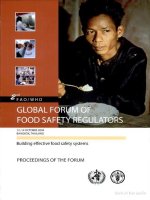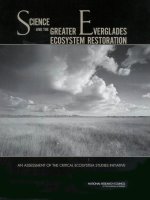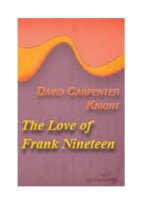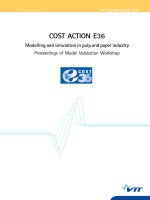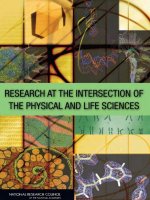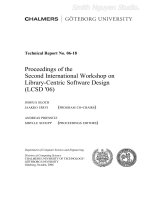- Trang chủ >>
- Khoa Học Tự Nhiên >>
- Vật lý
NSTAR 2001 Proceedings of the Workshop on The Physics of Excited Nucleons pot
Bạn đang xem bản rút gọn của tài liệu. Xem và tải ngay bản đầy đủ của tài liệu tại đây (30.09 MB, 528 trang )
NSTAR 2001
Proceedings of the Workshop on
. The Physics of Excited Nucleons
^S^*?ft
D.
Drechsel & L. Tiator
World Scientific
NSTAR 2001
Proceedings of the Workshop on
The Physics of Excited Nucleons NSTAR 2001
Proceedings of the Workshop on
The Physics of Excited Nucleons
Mainz, Germany 7-10 March 2001
Editors
D.
Drechsel
&
L. Tiator
Institut fur Kernphysik, Universitat Mainz, Germany
Vfe
World
Scientific
VI New Jersey London* Sinqapore* New Jersey
•
London
•
Singapore
•
Hong
Kong
Published by
World Scientific Publishing Co. Pte. Ltd.
P O Box 128, Farrer Road, Singapore 912805
USA office: Suite IB, 1060 Main Street, River Edge, NJ 07661
UK office: 57 Shelton Street, Covent Garden, London WC2H 9HE
British Library Cataloguing-in-Publication Data
A catalogue record for this book is available from the British Library.
NSTAR 2001
Proceedings of the Workshop on The Physics of Excited Nucleons
Copyright © 2001 by World Scientific Publishing Co. Pte. Ltd.
All rights
reserved.
This
book,
or parts
thereof,
may not be reproduced in any form or by any means,
electronic or mechanical, including photocopying, recording or any information storage and retrieval
system now known or to be
invented,
without written permission from the Publisher.
For photocopying of material in this volume, please pay a copying fee through the Copyright
Clearance Center, Inc., 222 Rosewood Drive, Danvers, MA 01923, USA. In this case permission to
photocopy is not required from the publisher.
ISBN 981-02-4760-5
Printed in Singapore.
NSTAR 2001
Workshop on
THE PHYSICS OF EXCITED NUCLEONS
Universitat Mainz, Germany
March 7-10, 2001
Organization
Conference Chairmen
V. Burkert (Jefferson Lab), D. Drechsel, and Th. Walcher (Mainz)
Organizing Committee
R. Beck (Mainz), V. Burkert (Jefferson Lab), D. Drechsel (Mainz),
E. Klempt (Bonn), M. Ripani (Genova), B. Saghai (Saclay), H. Schmieden
(Mainz), P. Stoler (RPI), L. Tiator (Mainz), Th. Walcher (Mainz)
Advisory Committee
G. Anton (Erlangen), C. Bennhold (GWU), L. Cardman (Jefferson Lab),
C. E. Carlson (Jefferson Lab), E. de Sanctis (Roma), S. Dytman
(Pittsburgh), A. Faessler (Tubingen), R. Frascaria (Orsay), N. Isgur
(Jefferson Lab), H. Lee (Argonne), V. Metag (GieBen), R. Milner (MIT),
T. Nakano (Osaka), B. Nefkens (UCLA), E. Oset (Valencia), C. Papanicolas
(Athen), W. Plessas (Graz), A. Radyushkin (Jefferson Lab), D. O. Riska
(Helsinki), A. Sandorfi (Brookhaven), B. Schoch (Bonn), S. Simula (Roma),
H. Stroher (Jiilich), W. Weise (Miinchen), R. Workman (GWU), S N. Yang
(NTU Taipei), B S. Zou (Beijing)
Institutional Sponsors
Deutsche Forschungsgemeinschaft
Jefferson Laboratory
Johannes Gutenberg-Universitat Mainz
State Government of Rhineland-Palatinate
V
This Volume contains both the invited lectures and the contributions to the
Workshop on The Physics of Excited Nucleons (NSTAR 2001), which was
held at the Johannes Gutenberg-Universitat Mainz, March 7-10, 2001. The
origin of this workshop series goes back to the conference on Excited Baryons,
which was initiated and organized by our late friend Nimai Mukhopadhyay
and his colleagues at the Rensselaer Polytechnic Institute in 1988. More recent
workshops of the series on N* physics took place at the Florida State Univer-
sity (1994), at CEBAF (1995), at the Institute for Nuclear Theory in Seattle
(1996),
at the George Washington University (1997), at the ECT* in Trento
(1998),
and at the Thomas Jefferson Laboratory in February 2000. Immedi-
ately before NSTAR 2001, the Baryon Resonance Analysis Group (BRAG)
had its working group meetings on resonance extraction and interpretation,
partial wave analysis, and database issues.
It was the aim of the Workshop to present the recent experimental and
theoretical results in the field of nucleon resonance physics. A wealth of new
high precision data was presented from facilities around the world, such as
BES,
BNL, ELSA, GRAAL, JLab, MAMI, MIT/Bates, SPring8, and Yerevan.
Particular emphasis was laid on polarization degrees of freedom and large
acceptance detectors as precision tools to study small but important transition
amplitudes, and the helicity (spin) structure of the nucleon. On the theory
side,
the impact was two-fold. First, there were new results describing the
nucleon resonance structure on the basis of Quantum Chromodynamics, either
directly in terms of quarks and gluons by means of lattice gauge theory, or
in terms of hadrons in the framework of chiral field theories. A status report
on duality showed the surprising connections between the physics of the low-
energy nucleon resonance region and the realm of quark structure functions
in deep inelastic scattering. Second, three sessions and the BRAG workshop
were devoted to an improved understanding of resonance structure in terms of
quark and other dynamical models and to a detailed data analysis by partial
wave expansions and coupled channels calculations, with the aim to establish
resonance properties in a unique and practically model-independent way.
The Workshop was attended by about 130 scientists from more than 50
universities and laboratories from 20 countries. We thank all the participants
for their valuable contribution to make the Workshop a success.
We wish to thank the institutional sponsors for their support: Deutsche
Forschungsgemeinschaft, Thomas Jefferson National Accelerator Facility, Jo-
hannes Gutenberg-Universitat at Mainz, and State Government of Rhineland-
VII
viii
Palatinate. We gratefully acknowledge the advice of the members of the In-
ternational Advisory Committee and the help of the members of the Local
Organizing Committee. Our special thanks goes to all the speakers who pro-
vided the basis for a successful conference.
We are very grateful to all the students who helped to organize the Sym-
posium and to Monika Baumbusch, Sabine Bua, Roswitha Drescher and Fe-
licia Ohl for handling the numerous administrative details. Finally, a special
note of thanks is due to Felicia Ohl for her expert assistance in preparing
these proceedings.
Mainz, June 2001
V. Burkert, D. Drechsel, L. Tiator, and Th. Walcher
CONTENTS
Organization v
Foreword vii
Nucleon Resonances in the Quark Model
S. Capstick 1
Quadrupole Strength in the N —> A Transition
C. Papanicolas 11
Pion Electroproduction at ELSA
R. Gothe 19
7T° Electroproduction in the A(1232) Region at MAMI
H. Schmieden 27
Pion Electroproduction Using CLAS
L. C. Smith for the CLAS Collaboration 35
Recoil Polarization Measurements in
TV°
Electro-
production at the Peak of the A(1232)
A. Sarty for the Jefferson Lab Hall A Collaboration 43
Chiral Effective Field Theories with Explicit Spin
3/2 Degrees of Freedom - A Status Report
Th. Hemmert 51
Dynamical Meson-Baryon Resonances with Chiral
Lagrangians
A. Ramos et al. 59
Chiral Lagrangians with Resonances
J. Oiler, U G. Meifiner 67
Pion Photo- and Electroproduction in Dynamical Model
T. Sato 75
Recent Developments in the Dynamical and Unitary
Isobar Models for Pion Electromagnetic Production
S. N. Yang et al. 83
Two Pion Production in the Jiilich Model
S. Krewald, S. Schneider, J. Speth 93
Update on Partial-Wave Analysis
R. Workman 101
Nucleon Resonance Properties in Multichannel
Approaches
C. Bennhold et al. 109
Variation of Hadron Structure with Quark Mass
A. W. Thomas 119
The Role of the Pion in Nucleon Resonance Structure
D O.
Riska 129
Relativistic Quark Models
S. Simula 135
Generalized Polarizabilities in a Constituent
Quark Model
S. Scherer, B. Pasquini, D. Drechsel 145
Nucleon Properties in the Perturbative Chiral
Quark Model
V. E. Lyubovitskij, Th. Gutsche, A. Faessler 155
The Glasgow Pion Photoproduction Partial
Wave Analysis, 2001
R. L. Crawford 163
3/2 3/2
Residues of the Multipole Amplitudes M^ E^
at the t-Matrix Pole Found in the Framework of
Dispersion Relations
I. G. Aznauryan 167
An Isobar Model for rj Photo- and Electro-
production on the Nucleon
W T. Chiang, S. N. Yang, L. Tiator, D. Drechsel 171
Detailed Analysis of
77
Production in Proton—Proton
Collisions
A. Svarc, S. Ceci 177
Phenomenological Analysis of N* Excitation in
Charged Double Pion Production
V. Mokeev et al. 181
Results on A(1232) Resonance Parameters:
A New TTN Partial Wave Analysis
G. Hohler 185
Solving the Puzzle of the jp
—>
7r+7r°n Reaction
J. C. Nacher et al. 189
The Giessen Model - Vector Meson Production on
the Nucleon in a Coupled Channel Approach
G. Penner, U. Mosel 193
Multipole Analysis for Pion Photoproduction with
MAID and a Dynamical Model
S. S. Kamalov, D. Drechsel, L. Tiator, S. N. Yang 197
Model Dependence of E2/M1
R. M. Davidson 203
Eta Photoproduction in a Coupled-Channels Approach
A. Waluyo, C. Bennhold, G. Penner, U. Mosel 207
Electroweak Properties of Baryons in a Covariant
Chiral Quark Model
S. Boffi et al. 213
Low Lying qqqqq States in the Baryon Spectrum
C. Helminen, D O. Riska 217
Parity Doublets from a Relativistic Quark Model
B.
Metsch, U. Loring 221
A Dispersion Theoretical Approach to Virtual
Compton Scattering off the Proton
B.
Pasquini et al. 225
Neutron Charge Form Factor and Quadrupole
Deformation of the Nucleon
A. J. Buchmann 229
The Ground and Radial Excited States of the
Nucleon in a Relativistic Schodinger-Type Model
S. B. Gerasimov 233
Vector Meson Photoproduction in the Quark Model
Q. Zhao 237
Status of Nucleon Resonances with Masses
M < M
N
+ M„
L. V. Fil'kov et al. 241
Spin Structure of the A(1232) and Inelastic
Compton Scattering
A. I. L'vov 245
Structure of the Roper Resonance from a-Proton
and 7r-Nucleon Scattering
H P. Morsch, P. Zupranski 249
Structure of the Nucleon Investigated by Compton
Scattering
M. Schumacher et al. 255
Virtual Compton Scattering at Jefferson Lab:
Preliminary Results in the Polarizability Domain at
Q
2
= 1 and 1.9 GeV
2
S. Jaminion for the Jefferson Lab Hall A Collaboration 259
Measurement of the Cross Section Asymmetry
£ for 7p
—»•
7v°p over the Range E^ — 0.5 - 1.1 GeV
H. Hakobian et al. 263
Positive Pion Photoproduction and Compton
Scattering at GRAAL
V. Kouznetsov for the GRAAL Collaboration 267
Virtual Compton Scattering and Pion Electro-
production in the Nucleon Resonance Region
G. Laveissiere for the Jefferson Lab Hall A Collaboration 271
Single Spin Beam Asymmetry Measurements from
Single 7T° Electroproduction in the A(1232)
Resonance Region
K. Joo 275
The New Crystal Ball Experimental Program
W. J. Briscoe 279
Observation of 77-Mesic Nuclei in Photoreactions:
Results and Perspectives
G. A. Sokol, A. I. L'vov, L. N. Pavlyuchenko 283
Baryon Spectroscopy: Experiments at PNPI
I. Lopatin 287
Measurement of the Cross Section Asymmetry in
Deuteron Photodisintegration by Linearly Polarized
Photons in the Energy Range E
y
= 0.8 - 1.6 GeV
A. Sirunian et al. 291
Nucleon Resonances in Lattice QCD
F. X. Lee 295
Lattice Study of Nucleon Properties with Domain
Wall Fermions
S. Sasaki 303
Quark-Hadron Duality:
Resonances and the Onset of Scaling
W. Melnitchouk
311
Generalized GDH Sum Rule and Spin-Dependent
Electroproduction in the Resonance Region
J. P. Chen for the Jefferson Lab E94-010 Collaboration 319
Double Polarization Measurements Using the
CLAS at JLab
R. C. Minehart for the CLAS Collaboration 327
The Helicity Dependent Excitation Spectrum of
the Nucleon and the GDH Sum Rule
A. Thomas for the GDH- and A2-Collaborations 335
Static Magnetic Moment of the A(1232)
M. Kotulla for the TAPS and AS Collaborations 339
Meson Photoproduction at GRAAL
A. D'Angelo et al. 347
Maximum Likelihood Techniques for PWA of 2-Pion
Photoproduction
J. P. Cummings 355
rj Electroproduction with CLAS
J. A. Mueller 365
Kaon Electroproduction and A Polarization
Observables Measured with CLAS
B.
Raue for the CLAS Collaboration 373
Recent Results on Kaon Photoproduction at SAPHIR
in the Reactions jp
—>
K
+
A and 7p
—»•
K +S°
K H. Glander for the SAPHIR Collaboration 381
Vector Meson Decay of Baryon Resonances
U. Mosel, M. Post 389
Higher and Missing Resonances in u> Photoproduction
Y. Oh, A. I. Titov, T S. H. Lee 397
Photoproduction of Baryon Resonances, First
Data from the CB-ELSA Experiment
U. Thoma for the CB-ELSA Collaboration 405
Laser-Electron Photon Project at SPring-8
T. Nakano 413
The Baryon Resonance Program at BES
B.S.
Zou for the BES
Collaboration
421
Flavor Symmetry Studies with New Hyperon Data
from the Crystal Ball
B.
M. K. Nefkens et al. for the Crystal Ball
Collaboration
427
Higher Resonances and the Example of Two Pion
Electroproduction with the CLAS Detector at
Jefferson Lab
M. Ripani for the CLAS
Collaboration
439
Nucleon Resonances and Mesons in Nuclei
V. Metag 447
Excitation of Nucleon Resonances
V. D. Burkert 457
Summary of the Partial Wave Analysis Group of BRAG:
Multipole Analysis of a Benchmark Data Set
for Pion Photoproduction
R. A. Arndt et al. 467
Appendix
Author Index 493
Program of the Workshop 497
List of Participants
501
If
:•- :
S. CAPSTICK
Department of Physics,
Florida State University
Tallahassee, FL, 32306-4350, USA
E-mail:
Recent developments in the description of nucleon resonances using quark models
are surveyed, with an emphasis on how such models can be made more consistent,
both internally and with expectations from QCD.
1 Introduction
The study of nucleon resonances in the quark model can be used to identify
the effective degrees in baryons, and their properties. These effective degrees
of freedom undergo a confining interaction, and in most models they also have
a 'residual' interaction between them at short distances. Inclusive models are
described which attempt to describe all baryon states and a wide range of
their properties, and which differ mainly in their description of this residual
interaction between the quarks. Implementation of constraints due to chiral
symmetry remains to be achieved in inclusive models. Recent results from
lattice QCD calculations are outlined which may constrain models.
An important goal is to identify hybrid baryons (baryon states with the
confining glue in an excited state), and models such as the flux-tube model
can provide their quantum numbers and estimates of their masses and decay
properties.
Couplings to baryon-meson intermediate states can have important effects
on the baryon spectrum and should not be overlooked. Similarly, in order to
make models of nucleon resonances more realistic, their predictions for masses
and basic amplitudes must be combined with models of reaction dynamics in
order to describe observables in scattering reactions.
2 Effective Degrees of Freedom
In potential models of baryon structure the effective degrees of freedom are
taken to be constituent quarks, with effective light quark masses in models
with a relativistic kinetic energy of roughly 220 MeV, and in non-relativistic
models roughly 330 MeV. Strange quarks have masses from 420-550 MeV. The
constituent quarks are not point-like, but have electromagnetic and strong
1
2
form factors. The strong form factors are usually taken to be Gaussian or
monopole, with heavier quarks being more point like. These form factors nec-
essarily make finite the contact interactions between the quarks, which are
otherwise proportional to <$
3
(rj
—
r.,). Electromagnetic form factors for the
quarks have proven necessary to fit the nucleon form factors, even in rela-
tivists calculations based on light-cone dynamics
1>2
. A typical choice is a
monopole form for the F{ form factor of quark flavor i, and a dipole form for
i<2,
proportional to an assumed anomalous magnetic moment Kj. It has been
shown in a lattice QCD calculation
3
(similar results are obtained by con-
sidering baryon-meson intermediate state contributions to baryon structure)
that the /tj can not be considered universal, but are dependent on the baryon
state in which the quarks reside.
Baryons have been described as a quark plus a diquark cluster. The sim-
plest of these models uses a tightly-bound scalar-isoscalar diquark, a channel
in which the short-range forces between quarks are known to be attractive.
Such models have fewer degrees of freedom at energies too low to break up
the diquark, which implies fewer low-lying excited states. The identification
of several positive-parity baryon states in the
1.7-2.1
GeV range which are
predicted by symmetric quark models, but currently 'missing' from analyses,
would rule out such models. A model based on a spectrum-generating alge-
bra
4
describes excited states in terms of collective excitations of string-like
objects which carry the quark quantum numbers, with radial excitations aris-
ing from rotations and vibrations of these strings. As the degrees of freedom
are extended, there are more excited states, some of which would be described
in other models as excitations of the confining glue.
The constituent quark model in its standard form does not possess the
chiral symmetry present in QCD. The incorporation of chiral symmetry into
a model which describes the structure of low-lying baryons was accomplished
using the cloudy-bag model
5
, which puts together light quarks in a bag with
pions coupled to the surface. Here the effective degrees of freedom are cur-
rent quarks moving relativistically inside a (spherical) bag surface, and pions.
Although successful at describing the electromagnetic properties of predomi-
nantly spherical ground states, the generalization of such a model to excited
states of the quarks likely to deform the bag away from a spherical shape
is technically involved. Calculations of nucleon and A properties using the
Schwinger-Dyson Bethe-Salpeter approach
6
are in progress. These difficult
calculations are covariant, and exhibit exact chiral symmetry with dynami-
cally generated running quark masses. Work is also underway to build a chiral
quark model based on the Hamiltonian approach
7
to QCD.
3
3 Confining Interaction
A modern picture of the confining interaction between the quarks is that
it is provided by flux tubes of lengths k emanating from the quarks which
meet at a junction. In the adiabatic approximation this gives a confining
interaction from the minimum length of these tubes
8
for a given set of quark
positions V(r) = a J^i h
=
c-kmin, where a is the meson string tension, which
is obviously linear for large quark-junction separations. This picture implies
the existence of new excited states based on excitations of the flux tubes.
Confirmation of this picture for heavy-quark systems has been provided
by a quenched lattice measurement of the QQQ potential using a Wilson loop
for three static quarks
9
. The resulting potential is fit to a form
V
3
Q = -A
3Q
^ Vl
r
i -
r
jl +
CT
3
Q£min
+ C
3
Q- (1)
The QQ potential is also measured and fit to a constant plus (attractive)
Coulomb plus linear form, in order to compare the strengths of the linear and
Coulomb terms. The results show that the string tensions are similar in heavy-
quark mesons and baryons, and that the coefficients of the baryon and meson
Coulomb terms are in the ratio 1/2 expected from one-gluon-exchange (OGE)
or a similar Aj • Xj potential. By examining many sets of quark positions it
is also shown that the confining potential is not fit well by a constant times
the sum of the inter-quark separations (a 'A' potential), which reinforces the
flux-tube picture described above, at least for heavy quarks.
4 Residual Interactions
The spectrum of the flavor octet and decuplet ground-state baryons shows
flavor dependent short-range (or contact) interactions between the quarks. A
good fit to the masses of these states can be made assuming that its source is
a OGE color-magnetic dipole-dipole interaction of the form
This yields, for example, the relation (ME -
M\)/(MA
- Mjv) = (2/3) (1 -
fn
Ut
dlm
a
) which is capable of explaining the E - A mass difference with a
ratio of light to strange quark masses which fits other physics of these states,
such as the magnetic moments. This interaction also has the advantage that
it explains regularities in the meson spectrum, such as the evolution of the
4
vector-pseudoscalar mass splitting with quark mass. Note that this is a non
relativistic form and so it is not clear why it should work for light quark
systems.
The adoption of OGE for the contact interaction implies the presence of
tensor and spin-orbit interactions between the quarks, with strengths com-
mensurate with that of the contact interaction. While there is no strong
evidence for the tensor interaction from fits to masses which come out of par-
tial wave analyses, there is some evidence from the strong and electromagnetic
decays of these states that the mixings between states caused by a one-gluon
(or other vector) exchange tensor interaction are present. A good example is
the large Nr) decay width for the lighter of the two Su states at 1535 MeV
and the small Nr] width for the heavier state at 1650 MeV, which can be
explained as due to mixing between the quark-spin-1/2 and 3/2 states caused
by the tensor interaction of the strength implied by the contact interaction
10
.
Although there are also spin-orbit interactions arising from the Thomas
precession of the quarks in the confining potential, and there is a partial
cancellation of these with the OGE spin-orbit interactions, the spin-orbit in-
teractions which accompany the contact and tensor interactions in the non-
relativistic model cause splittings which are unphysically large.
A variational calculation in a large basis allows the use of a relativistic
kinetic energy and parametrized relativistic corrections to the potentials of
the kind expected from examining the OGE T-matrix element away from
the non relativistic limit
n
. Using a string model for confinement plus the
associated spin-orbit interactions, as well as all of the interactions expected
from OGE, a reasonable fit to the spectrum of all baryons can be made. Spin-
orbit interactions are smaller, partly due to the use of a smaller a
s
once the
contact interactions are smeared over the constituent quark size and evaluated
without resort to wave function perturbation theory, and partly by choosing
the relativistic parameters to make them so.
Another possibility for the residual interactions are caused by the ex-
change between light quarks of pions
12
>
13
,
or an octet of pseudo-Goldstone-
boson pseudoscalars
14
. This gives a contact interaction with explicit SU(3)
flavor dependence in addition to the dependence on quark masses. Using
this model it is possible to arrange for the lightest radial excitations, like
M/2+(1440), A3/2+(1600), and Al/2+(1600) with masses similar to, or in
the case of the Roper resonance, lighter than those of low-lying negative-parity
states of the same flavor, by fitting the radial matrix elements of the contact
potential to the spectrum. More sophisticated calculations in large variational
bases exist
15
which calculate these matrix elements along with the associated
tensor interactions, a relativistic kinetic energy and string confinement, with
5
additional potentials due to the exchange of a nonet of vector mesons and a
scalar expected from exchange of two pions. This model can also provide a
reasonable fit to the low-lying states in the spectrum.
A second explicitly flavor-dependent possibility is that the residual in-
teractions are instanton induced, which can cause an short-range (contact)
attractive interaction between two quarks in an 5-wave, / = 0, S — 0 state.
The result is a model
16
with few parameters which has been applied to the
ground and excited states with reasonable success for the ground states and
non-strange orbitally excited states, but with splittings in the orbitally ex-
cited X states and with positive-parity states generally too heavy by about
250 MeV.
5 Lattice Results
Quenched lattice results are available for the spectrum of ground state baryons
based on improved actions which require mild continuum extrapolations
17
,
with agreement within 10% with experiment. These calculations require (chi-
ral) extrapolations to reach physically meaningful quark masses, which may
not be linear as is usually assumed. The known structure of the chiral limit
can and should be incorporated
18
.
A description of a successful calculation of the mass of the lightest Nl/2~
baryon mass using domain-wall fermions to incorporate chiral symmetry is
elsewhere in these proceedings
19
. Interestingly, this quenched calculation
finds the lightest Nl/2
+
resonance heavier than the lightest Nl/2" state, in
agreement with other lattice determinations
20
-
21
. This suggests that effects
not present in the flavor-independent OGE quark model or in quenched lattice
QCD,
like threshold effects or coupling to baryon-meson intermediate states,
may be responsible for the low actual mass of the Roper resonance. It has been
shown that Nn
—>
Nmr reaction dynamics can generate a pole in the region
of the Roper resonance with no need for a qqq excitation of this mass
22
.
Similarly, these lattice calculations find the lightest Al/2
-
[corresponding
to A(1405)] roughly degenerate with the lightest Nl/2~ [corresponding to
Af(1535)],
hinting that the A3/2"(1520) - Al/2~(1405) splitting may also
have the same source.
6 Hybrid Baryons
Identification of hybrid baryons is complicated by the fact that they have
the same quantum numbers as conventional three-quark excitations, and so
should mix with conventional excitations. Their identification is also some-
6
what model dependent, as it relies on the separation of the gluon and quark
degrees of freedom inherent in some models. In the flux-tube model these are
described as baryon states built on excited flux tubes, so that in an adiabatic
approximation three quarks move in a confining potential generated by ex-
cited states of the flux tubes. It can be shown
23
that the excitation energy
of these tubes, for a given configuration of the quarks, is approximately that
of a moving junction with a calculable effective mass. Hybrid baryon masses
can then be found by solving for qqq energies in the usual manner, but using a
modified confining potential which includes this excitation energy, calculated
variationally, for all possible quark positions.
In this model the junction motion adds V = 1
+
to the orbital angular mo-
mentum of the quarks, with the result that the lightest states have L
p
= 1
+
.
With consideration of the quark spin and excited flux tube exchange symme-
try, and with the usual spin-spin interaction between the quarks, the lightest
hybrids are nucleons with J
p
= 1/2+ and 3/2+ at 1870±100 MeV, or A states
with J
p
= 1/2+, 3/2+, or 5/2+ at 2075±100 MeV, significantly heavier than
the roughly 1500 MeV predicted for states containing 'constituent' gluons in
the bag model
24
. Such states are in the middle of the region of positive-parity
baryons predicted by symmetric quark models but missing from analyses of
scattering data.
7 Effects of Decay Channel Couplings
It is reasonable to expect that baryon self energies due to the presence of
baryon-meson or qqq(qq) intermediate states, into which baryon states can
decay, should be comparable to their widths. If this is the case, the differences
between most inclusive calculations of the baryon spectrum become irrelevant
if they ignore the mass splittings induced by adding many such self energies.
The best calculations of these splittings
25
>
26
'
27
calculate the self energies of
ground and orbitally excited non strange and A and £ states due to inter-
mediate states made up of ground state baryons and the pseudoscalar octet
and vector nonet of mesons. Mesons are coupled to baryons as elementary
particles coupled directly to the quarks (elementary-meson emission, EME)
or using a pair-creation (
3
Po) model. Self energies are calculated by using
time-ordered perturbation theory
26
>
27
J
or by using dispersion relations
25
to
evaluate shifts in the mass squared.
The effects on baryon mass splittings are found to be substantial, of the
order of 50-100 MeV, making it possible to coarsely fit many aspects of the
spectrum entirely without residual interactions between the quarks. Some of
these baryon-meson intermediate state splittings resemble spin-orbit effects
27
.

